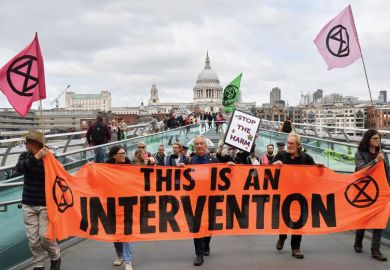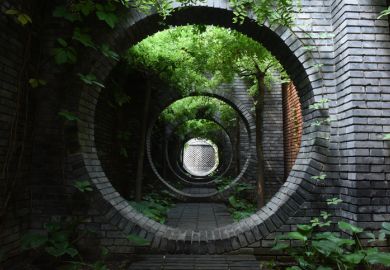The world is running short of fresh water - or at any rate water located near to where people are living. A few mighty rivers flow free to the sea through rainforests and Arctic tundra. But dozens of countries are or will soon be directly consuming most of the fresh water available within their borders. Many more are dipping deep into underground reserves, lowering water tables till the wells and boreholes run dry, or wrecking the hydrology of their rivers through ill-advised dam projects.
No wonder. The average western citizen personally consumes about a tonne of water every week, and even larger amounts are expended on irrigating crops or providing for other needs. A series of local water problems on individual rivers and aquifers is escalating into a global crisis.
And yet few scientists or other analysts have tackled water at the global scale. Peter Gleick, president of the Pacific Institute for Studies in Development in Oakland, California, is one of the few. His latest project, The World's Water: The Biennial Report on Freshwater Resources , is intended as the first in a series of reports that will, over the coming years, chart the development of the crisis. In a field without a well-developed review literature, it will leave many wondering why nobody thought of such a volume before.
Gleick is not a fan of large dams, whose follies get a chapter to themselves. The flooded river valleys and exiled communities, wrecked fisheries and eroding shorelines are all discussed. So are newer concerns such as earthquakes triggered by the vast masses of water trapped behind dams and the pollution from rotting vegetation bubbling up from the depths of rainforest reservoirs.
One of the more interesting developments Gleick mentions is the rise of the private-sector dam. The widely acknowledged economic failures of large dams often stem from their place in inefficient, militaristic and downright corrupt state construction systems. With the World Bank and other funding agencies pulling the plug on government dam projects, the private-sector turnkey project is likely to become the new norm. Proponents of dams hope this will revive what many, including Gleick, suspect is a dying industry.
One probability is that dams built with private funds are likely to give a higher priority to generating hydroelectricity - which provides a quick and almost guaranteed return provided someone remembers to build the pylons - and a lower priority to irrigating crops, for which the distribution infrastructure is more expensive and time consuming and the cash returns less assured.
Gleick gives some pertinent case studies. Both China's massive Three Gorges dam project on the Yangtze and the South African scheme to turn neighbouring Lesotho into a giant water tower are thoroughly reviewed. As are a series of modern conflicts over water - the potential "water wars", so beloved of alliterative headline writers.
Water disputes are not new, as Gleick's extensive and interesting chronology shows. Sumerian leaders were cutting each other's levees more than 4,000 years ago. And Moses's hydrological escapades on the Nile as the Israelites escaped from Egypt are categorised by Gleick as an act of water warfare. But such disputes are growing more frequent and intense. He lists 32 international water conflicts in the past 60 years.
Gleick is not concerned only with rivers. He covers the whole water cycle.Much of his early work in the water debate concerned apocalyptic scenarios of how the world would dry out under the harsh glare of global warming. Overall, precipitation will probably rise because of increased evaporation, which will make the air more moist. Indeed detailed studies over both the United States and the former Soviet Union already show increases in rainfall of about 10 per cent during the past century. But though the hydrological cycle will be working faster, there will be no more water in total. That same evaporation will cause soils to dry out faster, leaving crops desiccated.
Moreover, the anticipated movement of climate systems will create new arid zones and much greater uncertainty among farmers about when and where it is likely to rain.
Gleick's strength is his ability to span different disciplines in pursuing the theme of world water. He is both holistic and forensic. He is as fluent in water laws as in water wars, in water economics as in water ecology. He includes a section on evolving scientific theories about where the world's water came from. Did it emerge from volcanoes, as conventionally assumed, or, as some now think, arrive aboard millions of icy comets bombarding the atmosphere? He follows that with a rundown of the companies developing schemes to transport water cheaply around the world using sealed bags.
But he homes in time and again on key policy debates. He knows that what matters most about most irrigation projects is who gets the water - and who loses out because of its diversion. The creeping commodification of water is one of the unspoken themes of this volume. And in his concluding chapter he tackles the scandalous waste of water that characterises almost every nation on earth.
Water has always been treated as a near- universal right, the quintessential free resource. It is massively subsidised by most countries and under all political systems. But can this go on when more than half the water extracted from rivers and aquifers to irrigate crops never goes near a cultivated plant? When aquifers are habitually over-
abstracted with no regard for the future? When the world's fourth largest inland sea, the Aral Sea, can be sucked almost dry to irrigate cotton fields?
In an industry top-heavy with supply-side solutions to its problems, demand management is the real challenge. The World Bank wants to bring about efficient water use through privatisation and realistic water pricing. But of all resources, water is the one that most requires distribution according to need rather than greed, and one where the economies of mass universal provision are most apparent. Here is a conundrum awaiting the discovery of a "third way".
This book can certainly be improved in future editions. Somebody might get round to checking the data in the figures against those in the text. For instance, Gleick says: "In China, over ten million people were officially displaced by water projects between 1960 and 1990." Yet on the facing page a figure gives those displaced by dams at 2.5 million. Can both be true? If so, what manner of water projects displaced the other 7.5 million, and why are they not mentioned? It will probably take years to sort out the statistical mess that currently passes for global hydrological data. But to get a handle on the state of one of the world's critical resources, you have to start somewhere. And Gleick's admirable synthesis is undoubtedly the place.
While water is clearly a global resource, it is also intensely local. Rivers are one of the defining attributes of a locality. No two rivers are the same. And people grow very attached to their rivers. Take the Los Angeles River, subject of Blake Gumprecht's absorbing study. Once it meandered through woodlands of willow and sycamore, irrigated vineyards and orange groves, and filled the taps of the city's early inhabitants. It had marshes; grizzly bears roamed its shoreline and scooped trout from its waters. It was the reason why this part of southern California had one of the largest populations of native Indians anywhere in North America.
What is it today? A concrete-lined sewer almost from its source to the sea. Engineers, fearing the floods that sustained the river's lush marshes,canalised it, straightening, deepening and widening it so as to rush its slow-moving, life-giving waters to the sea. Then they began pouring the city's waste into the vast hydrological causeway they had created.
Gumprecht is a geographer and journalist. He covers the cultural and historical legacy of the river as well as its abused hydrology. In so doing, he brings to life a half-forgotten landscape buried beneath one of the largest cities on earth. But he is also bang up to date on modern mores - on what kind of world it is in which a Los Angeles politician could not so long ago campaign for the concrete bed of the river to be painted blue "to make it look more like a river".
He asks, could the old river be recreated? More and more Californians are beginning to ask why not: in a country that is tearing down some of its large dams to recreate natural fisheries, the idea of returning rivers to nature is not far fetched. The key question will be whether reviving a natural river can be compatible with flood prevention.
And what happens in Los Angeles will, inevitably, be watched round the world. London, for instance, is long overdue a campaign to revive its lost rivers. Not just the Thames, corseted by its embankments, but the Fleet and Brent and Wandle and numerous others, half hidden, litter strewn, canalised and, the ultimate indignity, sent underground in giant sewer pipes. If the Los Angeles River is today the worst of urban rivers, its revival could resonate far beyond the environs of southern California.
The politics of rivers is also high politics - not least in the parched Middle East, where the spectre of water wars is ever present. Martin Sherman, a political scientist at the University of Tel Aviv, has written The Politics of Water in the Middle East . It bears the subtitle "an Israeli perspective". More "Israeli perspectives" on water politics in the Middle East have crossed my desk in the past five years than on almost any other topic. I have not yet seen an "Arab perspective" or "a Palestinian perspective" - and precious few independent ones either. But most Israeli books preach the gospel of sharing this vital resource as a key to sharing the land. Most Israeli hydrologists are doves and believe there are technical solutions to the region's water-security problems that peace-minded politicians can promote to the benefit of all.
Not so Sherman. His is a hard-line testament. Israeli politicians, he says, have forgotten that "implementation of the proposed peace initiatives [the Oslo accords and calls for Israeli evacuation of the Golan Heights] would inevitably leave almost 70 per cent of Israel's water supply under total Arab control". He suggests that peace must leave Israel with that "total control" for itself. Jordanians and Palestinians, who have lived under Israeli control of most of their water for some decades, are hardly likely to take this position well. It was not a friendly act for Israel to divert most of the flow of the River Jordan into a pipeline called the National Water Carrier, but this little episode is not discussed. Anyone for a water war?
Fred Pearce is a freelance environmental writer and author of The Dammed .
The Los Angeles River: Its Life, Death and Possible Rebirth
Author - Blake Gumprecht
ISBN - 8018 6047 4
Publisher - Johns Hopkins University Press
Price - £33.00
Pages - 355


